1993 CHEVROLET SUBURBAN engine overheat
[x] Cancel search: engine overheatPage 6 of 386
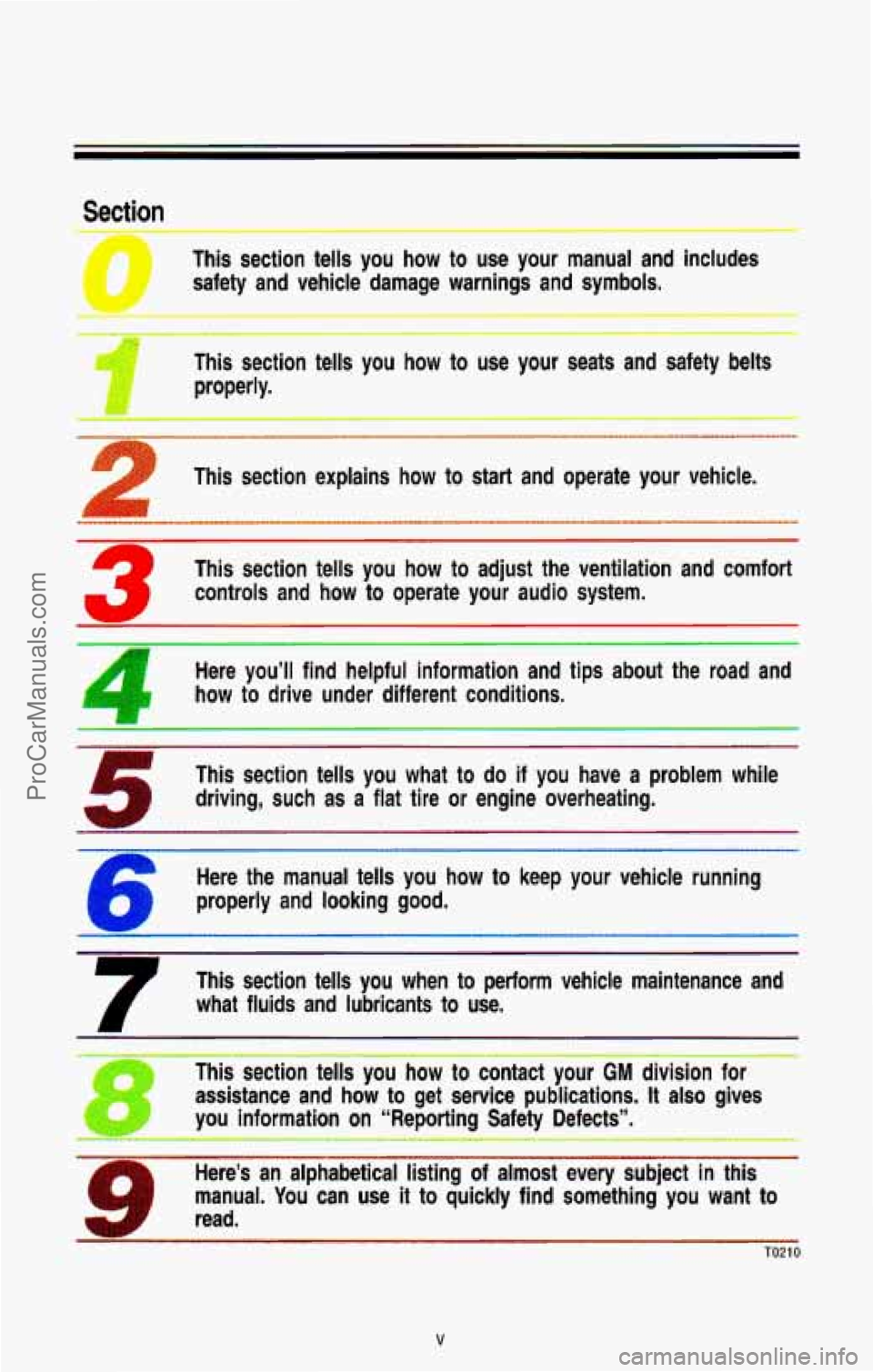
Section
0
This section tells you how to use your manual and includes
safety and vehicle damage warnings and symbols.
L
A
This section tells you how to use your seats and safety belts
properly.
1 This section explains how to start and operate your vehicle.
3
This section tells you how to adjust the ventilation and comfort
controls and how to operate your audio system.
Here
YOU II find helpful information and tips about the road and
how to drive under different conditions.
5
This section tells you what to do if you have a problem while
driving, such as
a flat tire or engine overheating.
Here the manual tells you how to keep your vehicle running
properly and looking
good.
This section tells you when to perform vehicle maintenance and
what fluids and lubricants to use.
This section tells you how
to contact your GM division for
assistance and how to get service publications.
It also gives
you information on “Reporting Safety Defects”.
an alphabetical listing of almost every subject in this
1. You can use it to quickly find something you want to
TO21 0
V
ProCarManuals.com
Page 79 of 386
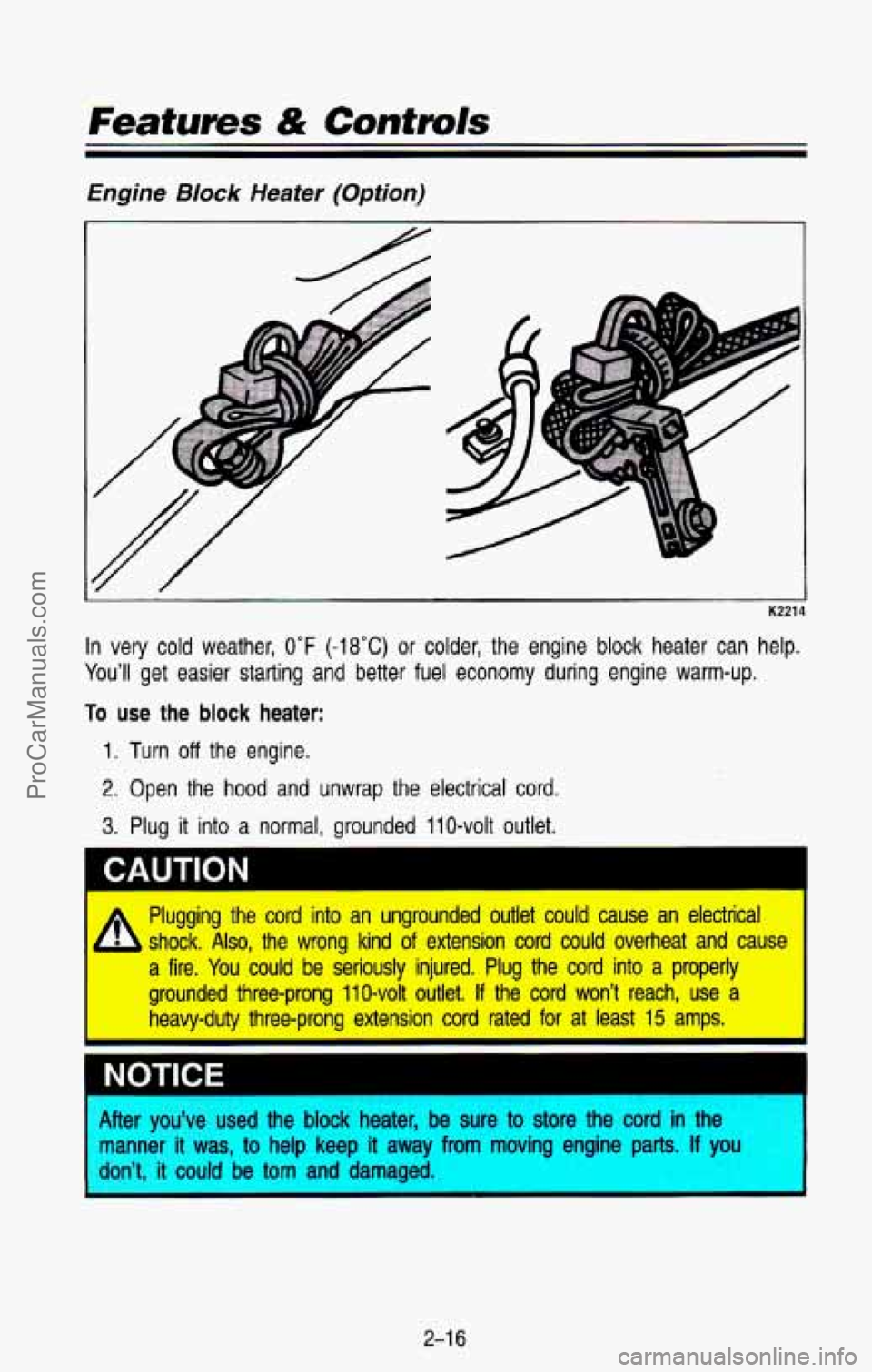
Features & Controls
Engine BIock Heater (Option)
i K221
In very cold weather, 0°F (-18°C) or colder, the engine block heater can help.
You’ll get easier
starting and better fuel economy during engine warm-up.
To use the block heater:
1. Turn off the engine.
2. Open the hood and unwrap the electrical cord.
3. Plug it into a normal, grounded 110-volt outlet.
I 4
1
Plugging the cord into an ungrounded outlet muld cause an electrical
L shock, Also, the wrong kind of extension cord could overheat and cause
a fire. You could be seriously injured. Plug the cord into a properly
grounded threeprong 110-volt outlet. If the cord won’t reach, use a
heavy-duty threepmng extension cord rated for at least 15 amps.
I
I NOTICE
ter you’ve used the block heater, be sure to store the cord in the
nanner
it was, to help keep it away from moving engine parts. If you
lon’t, it could be tom and damaged.
2-1 6
ProCarManuals.com
Page 89 of 386

Features & Controls
Leaving Your Vehicle With the Engine Running (Automatic
Transmission Models Only)
A It can be dangerous to leave your vehicle with the engine running.
h Your vehicle could move suddenly if the shift lever is not fully in
P (Park) with the parking brake firmly set.
If you have four-wheel drive with a manual transfer case shift le\
ver
and your transfer case
is in N (Neutral), your vehicle will be free to
roll, even
if your shift lever is in P (Park). So be sure the transfer
case is in a drive gear-not in
N (Neutral).
And,
if you leave the vehicle with the engine running, it could
overheat and even catch fire. You or others could be injured. Don’t
I leave your vehicle with the engine running unless you have to.\
If you have to leave your vehicle with the englne runnmg, De sure your
vehicle is in
P (Park) and your parking brake is firmly set, before you leave
it.
If you have four-wheel drive with a manual transfer case shift le\
ver, be sure
that the transfer case is in a drive gear-not in
N (Neutral).
After you’ve moved the shift lever into the
P (Park) position, hold the regular
brake pedal down. Then,
see if you can move the shift lever away from
P (Park) without first pulling it toward you.
If you can, it means that the shift lever wasn’t fully locked \
into P (Park).
Parking Your Vehicle (Manual Transmission Models Only)
Before you get out of your vehicle, put your manual transmission in
R (Reverse) and firmly apply the parking brake.
If you have four-wheel drive, be sure your transfer case is in a drive gear.
Your vehicle could roll
if it isn’t.
If you are parking on a hill, or if your vehicle is equipped to tow a trailer,
see “Towing a Trailer” or “Parking on Hills” in the Index.
2-26
ProCarManuals.com
Page 140 of 386
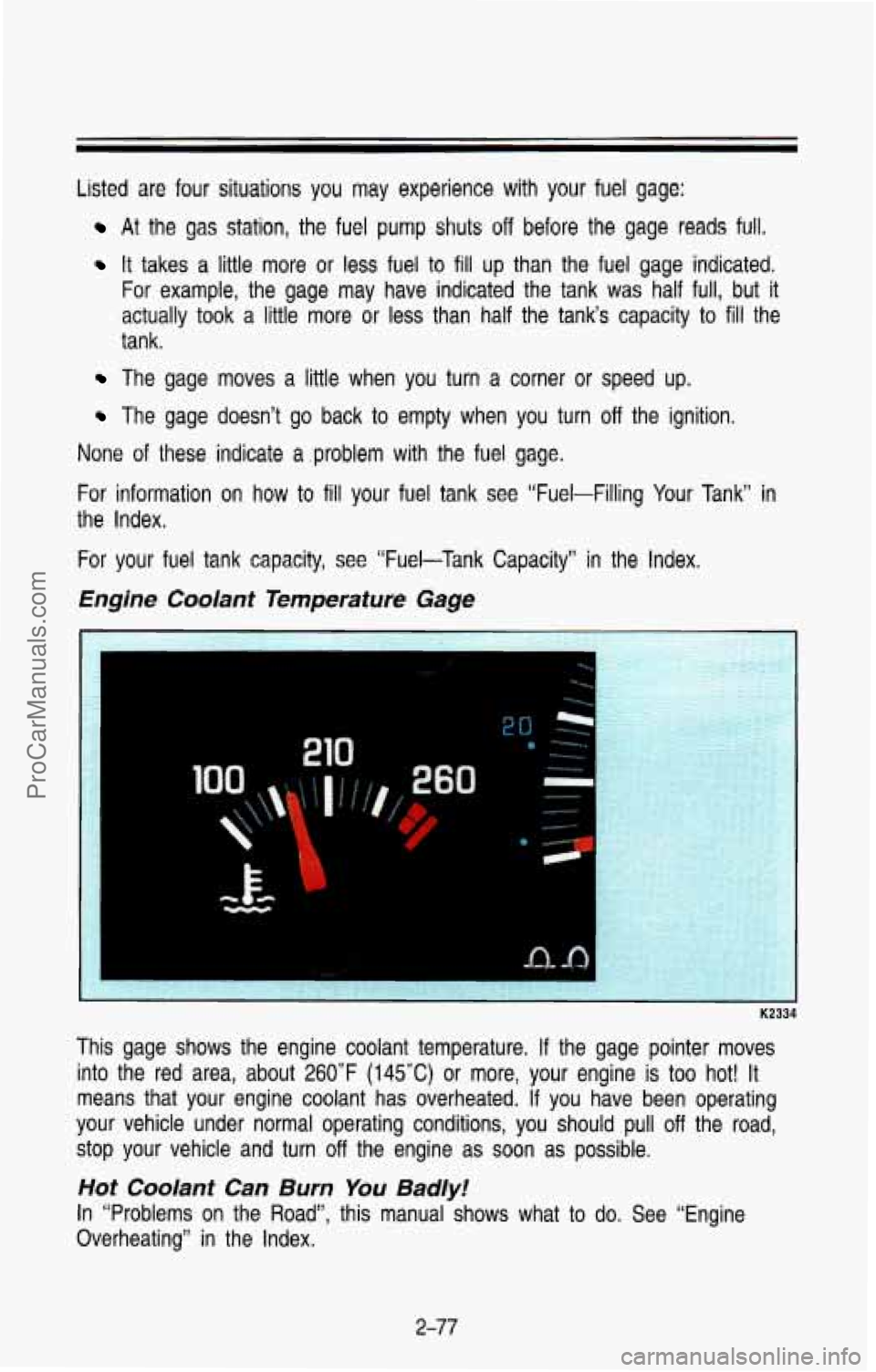
Listed are four situations you may experience with your fuel gage:
At the gas station, the fuel pump shuts off before the gage reads full.
It takes a little more or less fuel to fill up than the fuel gage indicated.
For example, the gage may have indicated the tank
was half full, but it
actually took a little more or less than half the tank’s capacity to
fill the
tank.
The gage moves a little when you turn a corner or speed up. \
The gage doesn’t go back to empty when you turn off the ignition.
None
of these indicate a ,problem with the fuel gage.
For information on how to
fill your fuel tank see “Fuel-Filling Your Tank” in
the Index.
For your fuel tank capacity, see “Fuel-Tank Capacity”
in the Index.
Engine Coolant Temperature Gage
260
This gage shows the engine coolant temperature. If the gage pointer moves
into the red area, about 260°F
(145°C) or more, your engine is too hot! It
means that your engine coolant has overheated.
If you have been operating
your vehicle under normal operating conditions, you should pull \
off the road,
stop your vehicle and turn
off the engine as soon as possible.
Hot Coolant Can Burn You Badly!
In “Problems on the Road”, this manual shows what to do. See “Engine
Overheating” in the Index.
2-77
ProCarManuals.com
Page 198 of 386

What’s at the bottom of the hill? Is there a hidden creek bank or even a
river bottom with large rocks?
If you decide you can go down a hill safely, then try to keep your vehicle
headed straight down, and use a low gear. This way, engine drag can help
your brakes and they won’t have to do all the work. Descend slowly, keeping
your vehicle under control at all times.
’ [ Heavy braking when going down a hill can cause your brakes to
overheat and fade. This could cause
loss of control and a serious
accident. Apply the brakes lightly when descending a hill and use a
I low gear to keep vehicle speed under control. 1
Q: Are there some things I should not do when driving down a hill?
A: Yes! These are important because if you ignore them you could lose
control and have
a serious accident.
When driving downhill, avoid turns that take you &%C>Ss the incline of the
hill.
A hill that’s not too steep to drive down may be too steep to drive
across. You could roll over
if you don’t drive straight down.
Never go downhill with the transmission in N (Neutral), or with the clutch
pedal depressed in a manual shift. This is called “free-wheeling.” Your
brakes will have to do all the work and could overheat and fade.
Q: Am I likely to stall when going downhill?
A: It’s much more likely to happen going uphill, But if it happens going
downhill, here’s what to do.
Stop your vehicle by applying the regular brakes. Apply the parking
Shift to P (Park) (or to Neutral with the manual transmission) and, while
Shift back to a low gear, release the parking brake, and drive straight
brake.
still braking, restart the engine.
down.
If the engine won’t start, get out and get help.
Driving Across an Incline
Sooner or later, an off-road trail will probably go across the incline of a hill. If
this happens, you have to decide whether to try
to drive across the incline.
Here are
some things to consider:
4-3 1
ProCarManuals.com
Page 229 of 386
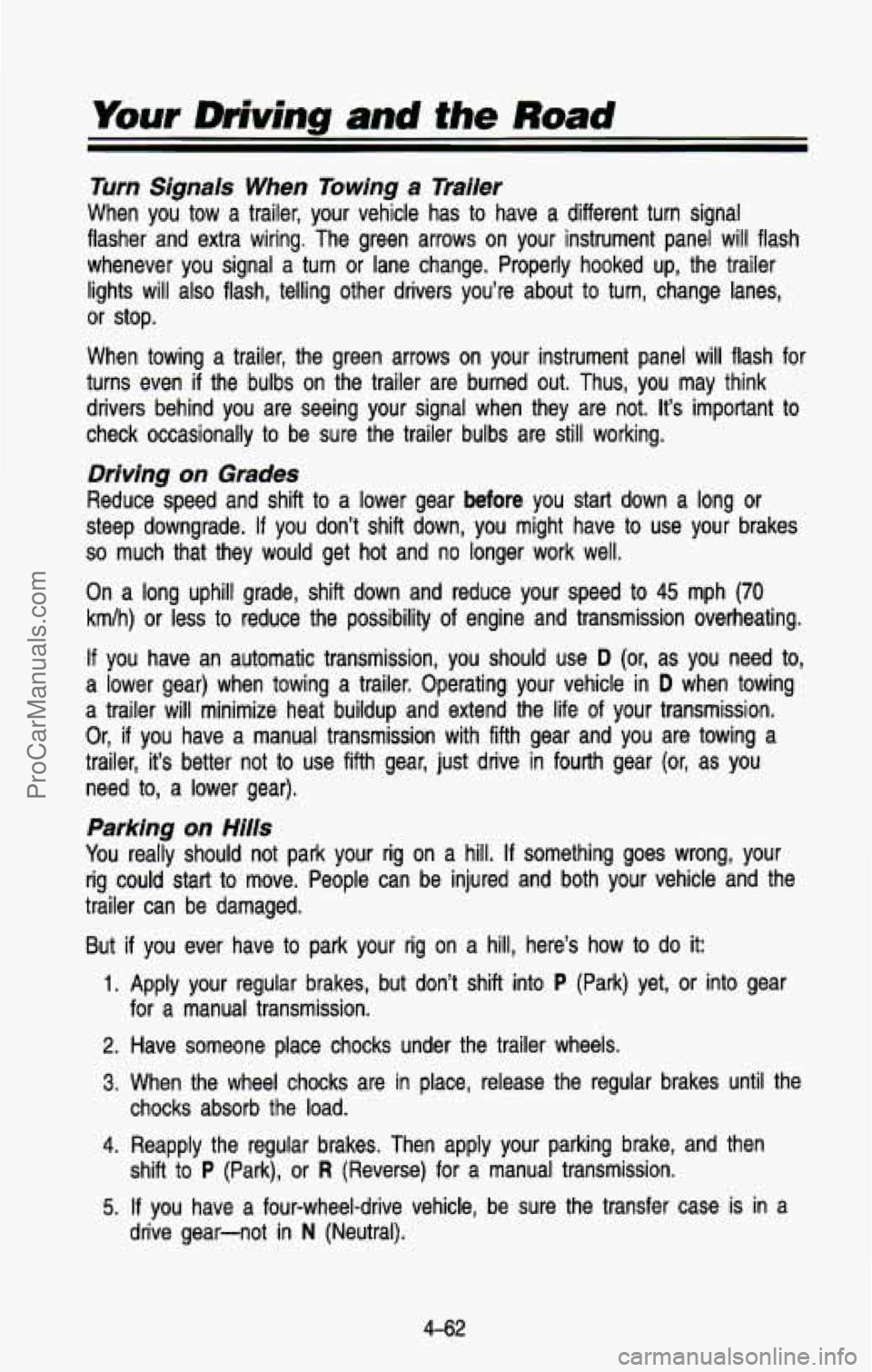
Your Driving and the Road
Turn Signals When Towing a Trailer
When you tow a trailer, your vehicle has to have a different turn signal
flasher and extra wiring. The green arrows on your instrument \
panel will flash
whenever you signal a turn
or lane change. Properly hooked up, the trailer
lights will also flash, telling other drivers you’re about
to turn, change lanes,
or stop.
When towing a trailer, the green arrows on your instrument pan\
el will flash for
turns even
if the bulbs on the trailer are burned out. Thus, you may think \
drivers behind you are seeing your signal when they are not.
It’s important to
check occasionally to be sure the trailer bulbs are still working.
Driving on Grades
Reduce speed and shift to a lower gear before you start down a long or
steep downgrade. If you don’t shift down, you might have to use your brakes
so much that they would get hot and no longer work well.
On
a long uphill grade, shift down and reduce your speed to 45 mph (70
kmlh) or less to reduce the possibility of engine and transmission overheating.
If you have an automatic transmission, you should use D (or, as you need to,
a lower gear) when towing a trailer. Operating your vehicle in D when towing
a trailer will minimize heat buildup and extend the
life of your transmission.
Or,
if you have a manual transmission with fifth gear and you are to\
wing a
trailer, it’s better not
to use fifth gear, just drive in fourth gear (or, as you
need to, a lower gear).
Parking on Hilk
You really should not park your rig on a hill. If something goes wrong, your
rig could start
to move. People can be injured and both your vehicle and the
trailer can be damaged.
But
if you ever have to park your rig on a hill, here’s how to do it:
1. Apply your regular brakes, but don’t shift into P (Park) yet, or into gear
for a manual transmission.
2. Have someone place chocks under the trailer wheels.
3, When the wheel chocks are in place, release the regular brakes\
until the
4. Reapply the regular brakes. Then apply your parking brake, and \
then
chocks absorb the load.
shift
to P (Park), or R (Reverse) for a manual transmission.
5. If you have a four-wheel-drive vehicle, be sure the transfer case \
is in
a
drive gear-not in
N (Neutral).
4-62
ProCarManuals.com
Page 232 of 386
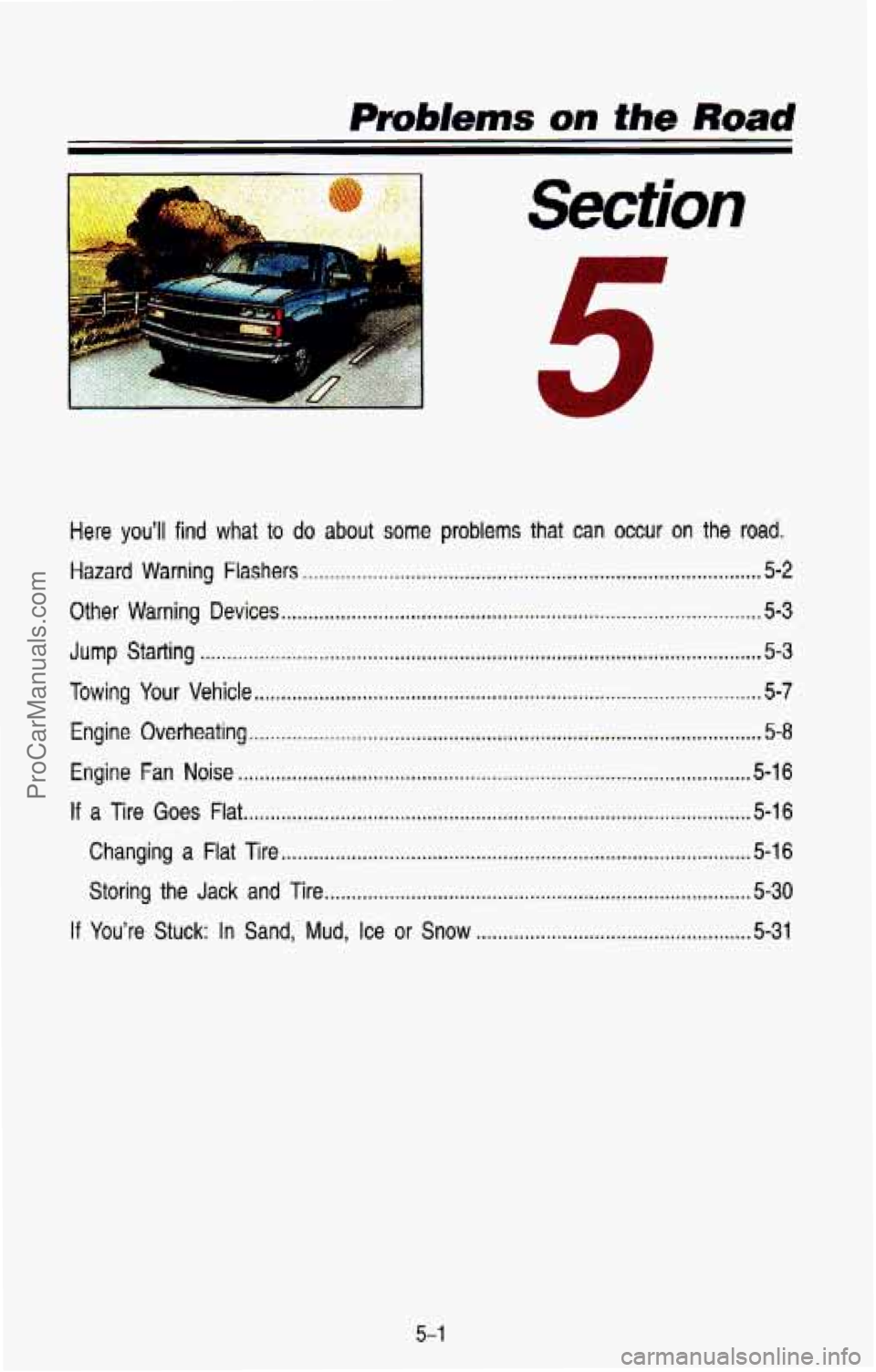
Here you’ll find what to do about some problems that can occur on the road.
Hazard Warning Flashers ........................................................................\
............. 5-2
Other Warning Devices ........................................................................\
................. 5-3
Jump Starting ........................................................................\
................................ 5-3
Towing Your Vehicle, ........................................................................\
..................... 5-7
Engine Overheating ........................................................................\
....................... 5-8
Engine Fan Noise ........................................................................\
....................... 5-1 6
If a Tire Goes Flat ........................................................................\
...................... 5-16
Changing a Flat
Storing the Jack
If You’re Stuck: In
Tire ........................................................................\
............... 5-16
and
Tire. ........................................................................\
...... 5-30
Sand, Mud, Ice or Snow ................................................... 5-31
5-1
ProCarManuals.com
Page 239 of 386
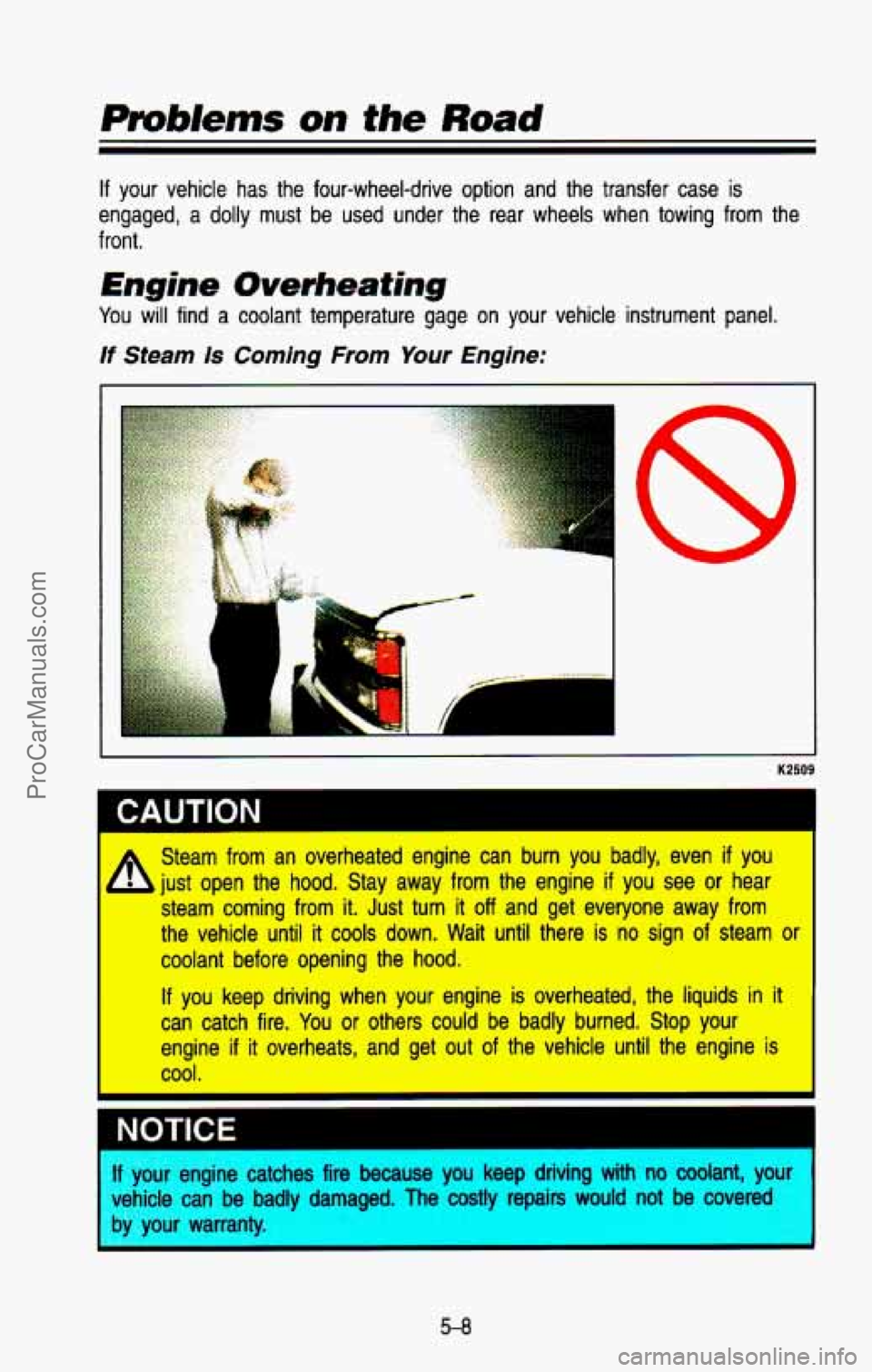
Pmbkms on the Road
If your vehicle has the four-wheel-drive option and the transfer case is
engaged,
a dolly must be used under the rear wheels when towing from the
front.
Engine Overheating
You will find a coolant temperature gage on your vehicle instrument panel,
If Steam Is Coming From Your Engine:
I
‘i Steam from an overheated engine can bum you badly, even if you
just open the hood. Stay away from the engine if you see or hear
steam coming from it. Just turn it off and get everyone away from
the vehide until it cools down. Wait until there is no sign of steam or
coalant before opening the hood.
If you keep driving when your engine is overheated, the liquids in it
can catch fire. You or others could be badly burned. Stop your
engine if it overheats, and get out of the vehicle until the engine is
Cool.
you keep driving with no coolant, your
costly repairs would not be covered
by
your warranty.
5-8
ProCarManuals.com